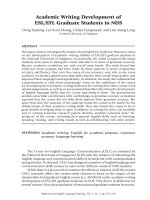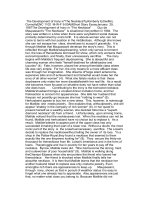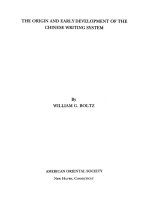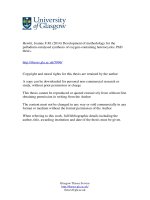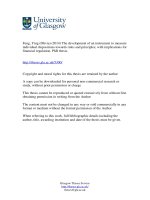Development of an extraction technique of determination of trace strontium
Bạn đang xem bản rút gọn của tài liệu. Xem và tải ngay bản đầy đủ của tài liệu tại đây (742.42 KB, 51 trang )
THAI NGUYEN UNIVERSITY
UNIVERSITY OF AGRICULTURE AND FORESTRY
NGUYEN HONG KIEN
TOPIC TITLE: DEVELOPMENT OF AN EXTRACTION
TECHNIQUE FOR DETERMINATION OF TRACE
STRONIUM
BACHELOR THESIS
Study mode
: Full-time
Major
: Environmental Science and Management
Faculty
: International Training and Development Center
Batch
: 2010-2015
Supervisor
: Assoc. Prof. Do Thi Lan
Prof. Wu, Chien Hou
Thai Nguyen, 15/01/2015
THAI NGUYEN UNIVERSITY
UNIVERSITY OF AGRICULTURE AND FORESTRY
INTERNATIONAL DEVELOPMENT AND TRAINING CENTER
DEVELOPMENT OF AN EXTRACTION TECHNIQUE
FOR DETERMINATION OF TRACE STRONIUM
BACHELOR THESIS
Student name : Nguyen Hong Kien
Major
: Environmental Science and Management
Faculty
: International Training and Development
Batch
: 2010-2015
Supervisor
: Assoc. Prof. Do Thi Lan
Prof. Wu, Chien Hou
Thai Nguyen - 2015
DOCUMENTATION PAGE WITH ABSTRACT
Thai Nguyen University of Agriculture and Forestry
Degree Program
Bachelor of Environment Science and Management
Student name
Nguyen Hong Kien
Student ID
DTN1053180064
Thesis title
Supervisors
Development of an extraction technique of determination
of trace strontium
Professor Wu, Chien-Hou and Assoc. Professor Do Thi
Lan
Abstract:
Strontium with its availability in environment and harmfulness to human health
has pulled a lot of attention as well as the studies from researchers all around the
world. Even though there are a lot of extraction methods for substance traces in
general and for strontium in particular, they still show their own drawbacks and
strengths. Therefore, it is very essential to develop more techniques for extraction
with the improvements from the previous methods. SPE and VALLME methods are
two of new extraction methods which are under progress of development, which
requires a lot of work in scientific field study.
This study delivers an overview picture for strontium toxicity which is currently
got the low awareness from people. Along with strontium toxicity, two extraction
methods which are solid phase extraction (SPE) and vortex-assisted liquid-liquid
microextraction method (VALLME) are presented with methodology, results and
discussion. The SPE-VALLME combined technique in order to maximize the
efficiency from SPE and VALLME had also been experimented.
This study has contributed knowledge and confirmation to SPE and VALLME
about its potential capacity in extraction and its reliability and accuracy for
extraction method study, especially for strontium extraction in water sample or
environmental sample.
i
Keywords
Strontium toxicity, extraction method, SPE, VALLME,
chromatography
Number of pages
44 pages
Date of submission
Jan 15th 2015
ii
ACKNOWLEDGMENT
First of all, I would like to express sincere thanks to the school board Thai
Nguyen University of Agriculture and Forestry, Faculty of International Training
and Development; Advanced Education program, thanks to the teachers who has
imparted to me the knowledge and valuable experience during the process of
learning and researching here.
This study was also supported and instructed by professor Do Thi Lan (Dean of
Faculty of Environment, Thai Nguyen University of Agriculture and Forestry,
Vietnam) and professor Wu, Chien-Hou (Department of Biomedical Engineering
and Environmental Sciences, College of Nuclear Science, National Tsing Hua
University, Hsinchu, Taiwan). I would like to give a special appreciation to Mr
Wang Chin-Yi for helping me in time of doing this study.
I sincerely thank you!
Taiwan, 2014
Student signature
NGUYEN HONG KIEN
iii
TABLE OF CONTENT
PART 1. INTRODUCTION...................................................................................4
1.1.
RESEARCH RATIONALE ................................................................................4
1.2.
RESEARCH’S OBJECTIVES ............................................................................4
1.3.
RESEARCH QUESTIONS AND HYPOTHESES ...................................................5
1.4.
STUDY SIGNIFICANCE ..................................................................................5
1.4.1. Scientific significance .............................................................................5
1.4.2. Practical significance .............................................................................5
PART 2. LITERATURE REVIEW.......................................................................7
2.1.
STRONTIUM..................................................................................................7
2.1.1. Strontium related definitions...................................................................7
2.1.2. Strontium when entering the environment ..............................................9
2.1.3. Strontium impact on health ...................................................................11
2.2.
STRONTIUM EXTRACTION ..........................................................................13
2.2.1. IC (Ion Chromatography) machine.......................................................13
2.2.2. Research’s ion chromatography ...........................................................16
2.2.3. Solid Phase Extraction (SPE) method ..................................................17
2.2.4. Vorted-Assisted Liquid-Liquid Mircoextraction (VALLME) ................18
2.3.
RESEARCH RELATED DOCUMENTS .............................................................19
PART 3. METHODS ............................................................................................25
3.1.
MATERIALS................................................................................................25
3.2.
EXPERIMENT ..............................................................................................25
3.2.1. Solid Phase Extraction..........................................................................25
3.2.2. Heating ..................................................................................................28
3.2.3. Vortex-Assisted Liquid-liquid Microextraction ....................................28
3.2.4. SPE-VALLME combined method ..........................................................29
PART 4. RESULTS...............................................................................................30
4.1.
4.2.
4.3.
SOLID PHASE EXTRACTION (SPE)..............................................................30
VORTEX-ASSISTED LIQUID-LIQUID MICROEXTRATION (VALLME) ........32
SPE-VALLME COMBINED METHOD .........................................................33
PART 5. DISCUSSION AND CONCLUSION ..................................................35
5.1.
DISCUSSION ...............................................................................................35
5.1.1. Solid phase extraction (SPE) ................................................................35
5.1.2. Vortex-Assisted Liquid-liquid Microextration (VALLME) ...................36
5.1.3. SPE-VALLME combined method ..........................................................38
5.2.
CONCLUSION .............................................................................................40
REFERENCES ......................................................................................................42
APPENDICES .......................................................................................................44
iv
LIST OF FIGURES
Figure 2.1 Methyl Methanesulfonate...................................................................... 16
Figure 2.2 Crown ether of Sr resin ......................................................................... 18
Figure 3.1 Spe method ............................................................................................ 26
Figure 3.2 Illustration of study experiment (SPE + VALLME)............................. 29
figure 4.1: Elution curves of strontium with repeated condition (1ppm sr in 3m
nitrate acid, 2ml of sample, 2ml of elution............................................................. 30
figure 4.2 Recoveries of SPE processes with repetition (2 ml of 1ppm sr sample in
3m nitric acid, 6 ml of elution) ............................................................................... 31
figure 4.3 The improvement in signals from standard solution, solution with SPE
applied and solution of SPE-VALLME combined method (100 ml of 20ppb
strontium sample) ................................................................................................... 34
figure 5.1 Illustration of VALLME experiment data for reliability (experiment with
10ppb, 25ppb, 50ppb, 100ppb, 300ppb, 500ppb, 1ppm, 1.5ppm).......................... 37
figure 5.2 The connection of SPE-VALLME combined method experiments’
results and reliability of the result (concentrations: 1ppb, 10ppb, 20ppb and 40ppb)
................................................................................................................................. 39
1
LIST OF TABLES
Table 4.1 Data for SPE experiment with peak area, peak height, recovery
(experiment with: 2 ml of 1ppm Sr sample in 3M nitric acid, 6 ml of elution)
........................................................................................................................ 32
Table 4.2 Data for VALLME experiment with concentration and peak area
(experiment with 10ppb, 25ppb, 50ppb, 100ppb, 300ppb, 500ppb, 1ppm,
1.5ppm) ........................................................................................................... 33
Table 4.3 Peak areas of standard and SPE-VALLME applied solutions with
concentration of 1ppb, 10ppb, 20ppb, 40ppb ................................................. 34
2
LIST OF ABBREVIATIONS
DIW
: Deioned water;
SPE
: Solid phase extraction;
VALLME : Vortex-Assisted Liquid-liquid Microextraction.
3
PART 1. INTRODUCTION
1.1.
Research rationale
Strontium extraction is rising as a hot topic in scientific study field. Strontium has
two types: the neutral and the radioactive. Both of them have significant impacts to
human health. While the toxicity of strontium is still mysterious to human
understanding due to its long-term impact for number of reasons, extraction method
for strontium is very essential. Currently, there are many extraction methods for
strontium available, however each of them has its own strengths and weakness while
the development of extraction method is never enough for scientific study, SPE and
VALME could be a suggestion contributing to lists of extraction methods for not only
strontium but for other substances (Chang W. Y. et al, 2012; Jakopic R and Benedik L,
2005). In addition, even Vietnamese people are not familiar with the strontium
especially strontium toxicity due to low level of strontium in its natural condition,
Vietnamese government is planning to build couple of nuclear power plants which
would accidently release some radioactive fallouts- one of them could be strontium
ninety. With study of SPE and VALLME for strontium extraction, it could help to
extract strontium ninety from environmental sample while with modification, SPE and
VALLME are able to work not only with strontium but other substances or
compounds.
1.2.
-
Research’s objectives
To study on the extraction methods for strontium which mostly focus on SPE,
VALLME and the combination of those two methods
4
1.3.
-
Research questions and hypotheses
What are the possible enrichment factor, recovery and reliability of SPE
method?
-
What are the possible enrichment factor, recovery and reliability of VALLME
method?
-
What are the possible enrichment factor, recovery and reliability of SPEVALLME combined method?
-
What are the limitations of extraction method of SPE-VALLME combined?
1.4.
Study significance
1.4.1. Scientific significance
With strontium toxicity and development of extraction techniques which focus on
SPE and VALLME, this study has succeeded some other studies’ knowledge with
further technical work and more specific substance trace. With its contribution, this
study also suggested a new way of study as well as the practical extraction method- the
combination of two extraction methods with their own modification as crown ether
applied in VALLME.
1.4.2. Practical significance
In context of globalization, environmental issues will become the hot topic not only
in single region but also in the world. As the increase of human awareness to substance
toxicity, the extraction methods for specific trace are highly required. More choices
and more applications for extraction methods will be studied and applied by
researchers all around the world. By the strength of SPE and VALLME and its
flexibility in modification, SPE and VALLME are promised to be a fast, simple
5
extraction method with high accuracy especially in context of Vietnam’s building
nuclear power plants and establishment of ASEAN community which possibly leads to
a lot of environment issues not only for Vietnamese but also for ASEAN researchers.
6
PART 2. LITERATURE REVIEW
2.1.
Strontium
2.1.1. Strontium related definitions
Strontium is a chemical element with atomic number of 38 and symbol Sr. It is an
earth alkaline metal and has highly reactive chemical ability in group IIA. Strontium in
pure form has soft silver-white color and turn to yellow just in condition of exposure
to air. Strontium is stable in nature under form of compound with another element
because of its highly reactivity to air and water. However synthetic 90Sr is a radioactive
fallout with half-life of 28.90 years in naturally physical process and 49.3 years in
biological process.
In nature, strontium is a common occurring element with two oxidation levels: 0
and +2. Mostly, in nature, due to high chemical ability, only +2 oxidation state of
strontium is stable and important. Pure strontium is a hard, white-colored metal, but
this form is not commonly existed in environment, but in form of compounds in
minerals. There are variety forms of strontium which do not give any smell exactly.
People can categorize strontium compounds in two different types: soluble and nonsoluble. Strontium in nature is not radioactive and exists in four different isotopes
which are strontium eighty-four, eighty-six, eighty-seven, eighty-eight, symbolized as
84
Sr, 86Sr, 87Sr, 88Sr. They have the same chemical behavior which leads them get the
same effects on health when entering the body.
Minerals in general (rocks, soil, dust, coal, oil, surface, ground water), air, plant,
animal or even human bodies contain certain amount of strontium. Typical
concentration in most of them are few parts per million (ppm). For industrial
production, strontium ore is taken from minerals of celestite (SrSO4) and strontianite
(SrCO3). After extracting from strontium ore, strontium is stored in form of compound
7
with other acid groups, such as carbonate, nitrate… through number of chemical
processes. The compound of strontium has varied applications in daily life products,
for instrance, glass products, pyrotechnics, paint paigments, fluorescent lights,
medicines and other…
There are several radioactive isotopes of strontium and one of those is strontium
ninety or 90Sr, which is most dangerous isotopes of strontium. Strontium ninety can be
formed in processes in nuclear reactors or nuclear weapon bomb. Radioactive
chemicals in general and strontium ninety in specific give off radiation to environment
which transform those chemical to other isotope of same or other element, named
decay process. Strontium ninety gives off radiation to turn to yttrium ninety (90Y)
which decays again to zirconium ninety (90Zr), being more stable isotope. The first
Sr to
90
strontium toxicity. Because
90
decay process (from
90
Y) has half-life of 29 years, which contributes more to
Sr has very limited use, it is considered as the waste of
production while 89Sr is used as a cancer therapeutic to alleviate bone pain and 85Sr is
used in medical treatment1.
For radioactive
90
Sr, it is formed via nuclear fission processes and has been
released to natural environment by atmospheric nuclear explosion, nuclear plant waste
discharge, nuclear weapon testing and Chernobyl accident in 1986.
daughter which is
decays to
90
90
Y and the process of decay into
90
90
Sr has its
Y takes 28.90 years but
Zr taking only 64 hours. Additionally in human body,
90
90
Y
Sr mostly
accumulates in bone tissues because of its biochemical, atomic structure similarity
with its neighbor elements Calcium and Barium. Most of Sr in human body deposits in
bone, which is possibly the reason for bone cancer and nearby tissue cancer. Because
of its danger to health, 90Sr has got a lot of attention from scientific field.
8
Agency for toxic substances and disease registry (ATSDR) of United Stated has
given their own health statement for strontium toxicity.
There are a lot of disposal places in the world and most of them are not authorized
to anyone for cleanup activities. Just in the US, at least 102 and 12 of 1,636 sites of
National Priorities List (NPL) sites, which contain names and places of all the waste
site with hazardous in US have been found strontium and strontium-90 in current list
and former list, respectively. Indeed total number of hazardous waste sites in specific
and disposal places in the world have not named fully, which leads to be under
evaluated and misinformative of strontium reserve and impacts of strontium to human
being. As the increasing of awareness of people, number of disposal sites which have
been detected for strontium is increased. This is very important because the exposure
of strontium especially radioactive strontium to community is very harmful.
As the other external exposure to radiation, strontium radiation exposure can be
from both nature and human activities. Natural sources of radiation could be from
outer space, radioactive materials from soil or building. Man-made sources for
radiation may be products, industrial material, nuclear weapon fallout or nuclear
reactors. Depending on the level of exposure to strontium and type of strontium,
victim’s status of health, people could suffer the different harmful impacts from
strontium.
2.1.2. Strontium when entering the environment
Stable and radioactive strontium compounds in the air are presented as dust.
Emissions from burning coal and oil increase stable strontium levels in the air, which
makes particles of strontium in air are mostly stable or non-radioactive strontium.
After time floating in air, strontium particles will be settled down to water, land, plant
9
surface by themselves or precipitation processes (rain, snow, smog,…). They could
follow the water current to take place in the bottom of river or lake where they will
stay or mix with other strontium particles including radioactive ones that already there.
In water, strontium is normally dissolved no matter it is stable or radioactive.
Because of taking place in earth alkaline group, strontium is easily dissolved in water
which is run over or through, which means in natural aquatic environment, strontium
from dust falling down to water is very few. Generally, amount of strontium found in
water is 1ppm, which is because of the falling down strontium from dust into water.
There are limited sources of information about
90
Sr in drinking water, according to a
report of EPA (Environment Protection Agency) in US,
90
Sr in drinking water in
different parts of US is less than 0.1 pCi/l or 0.004 Bq/l (1 litter of drinking water has
0.004 atoms transforming per second) (Agency for toxic substances and disease
registry, 2014).
In soil, there is very wide range of strontium amount but typically from 0.2
milligrams per kg (mg/kg) of soil (Agency for toxic substances and disease registry,
2014). This value could vary, depending on the location or concentration of strontium
in releasing places and waste. However the radioactive strontium occupies very small
fraction to strontium in soil but could be more if it is close to hazardous waste place or
radioactive waste site.
Strontium is found naturally in soil in amounts that vary over a wide range, but the
typical concentration is 0.2 milligrams per kilogram (kg) of soil (or 0.2 mg/kg)
(Agency for toxic substances and disease registry, 2014). The disposal of coal ash,
incinerator ash, and industrial wastes may increase the concentration of strontium in
soil. Generally, the amount of strontium ninety in soil is very small and is only a
10
fraction of the total concentration of strontium in soil. Higher concentrations of
strontium ninety in soil may be found near hazardous waste sites, radioactive waste
sites. Because of its easily soluble, strontium is likely to follow water to go deeper to
the ground but sometimes it could stay years in soil without going deeper because in
nature, there are a lot of chemical reactions making strontium compound from soluble
into insoluble form and reverts.
2.1.3. Strontium impact on health
Because of social reasons, harmful impact of toxic chemicals to human health will
be tested with scientific method which mostly focuses on procedure of absorption,
circulation, elimination of toxics by body. To understand that, scientists need to look at
the doses and behaviors of patients or testing animal. For radioactive chemicals in
general and strontium in specify, animal testing and case study are very necessary.
Strontium effect to human health is not an exception.
It is clear to state that there is no or very minor effects of stable strontium in human
with the typical amount in natural environment. The problem with stable strontium is
normally the lack of calcium and protein in diet for children, plus with the unusually
high level of strontium in food and drinking water, which leads to the formation of
bone by strontium rather than calcium (as mentioned above). This problem would
make the weakness in bone. Recently, there is no report on strontium with direct
contact with skin because of low level of strontium, short time of interacting.
Additionally, it is not known yet whether stable strontium has effect on reproduction
of human or animal.
Beside of effects on bone growth in young animals, there is very limited
information on effects of stable on cancer causing in human or animals. However,
11
radioactive strontium has a lot of impacts on human health, mostly because of its
radioactive effect.
Since the radioactive strontium accumulates in bone, it has a lot of harmful effects
to health because of long time of half-life and radiation effects to function of bones.
Firstly, due to radiation of strontium, the bone tissue and soft organs nearby get the
impact from radiation. Bone has biologically function as source of blood cells, which
means radiation from strontium to bone can cause the reduction in blood cells. This
could be witnessed in people who have injected
89
Sr for cancer treatment in bone
marrow (Agency for toxic substances and disease registry, 2014). This phenomenon is
also observed in animals that breathe or eat food contaminated with radioactive
strontium. When blood cells are reduced, many problems could occur. They are the
loss in ability of taking oxygen, leading to tiredness, or the loss in platelets which
results in clothing following with abnormal bleeding. The loss in white blood makes
the lower resistance to disease.
There is also evidence that impacts from radioactive strontium can occur even by
skin contact. For medical purpose, radioactive can be used to eliminate unwanted
tissues on eye or skin, which leads to the thin eye or skin tissues after the long time.
It is lacked of evidence showing the effect of radioactive strontium to human
reproduction. Reverse effects on animal reproduction happen when high level of
exposure to radioactive strontium which is much higher than typical level in nature.
However the destruction in genetic material (DNA) in cells has been reported. There
was a significant increase in leukemia in population that use the river water containing
large amount of 90Sr and other radioactive materials releasing by nuclear weapon plant.
Cancers of bone, nose and lung is the main consequence, which is also witnessed in
12
animals in neighbor area. The International Agency for Research on Cancer (IARC)
has listed radioactive strontium as carcinogenic to human because of its beta radiation
emission and deep deposit in human body.
2.2.
Strontium extraction
As the enhancement to the awareness of strontium toxicity, people tend to pay
more attention to it, along with its related study. Strontium has been raised as a favor
study research because of its availability in nature, toxicity in radioactive form. There
are a lot of methods to extract strontium. Each method has its own disadvantages and
advantages which could relate to time consuming, equipment requirement, complexity,
low efficiency...etc. This study would be a suggestion for extraction technique for
determination of traces which has its own advantages: less time consuming, equipment
independence and disadvantages: resin reliability. More information about strontium
extraction will be discussed in following parts of this report.
2.2.1. IC (Ion Chromatography) machine
Ion Chromatography is application of ion-exchange resins to analytical separation
by using materials of stationary phase and mobile phase to separate charged species. In
most of cases, conductivity is the parameter for separation.
There are two types of ion chromatography currently using: suppressor-based and
single-column. They differ in the method used to prevent the conductivity of the
eluting electrolyte from interfering with the measurement of analyte conductivities.
2.2.1.1. Ion Chromatography based on Suppressors
Conductivity detectors have many of the properties of the ideal detector. They can
be highly sensitive, they are universal for charged species, and, as a general rule, they
13
respond in a predictable way to concentration charges. Furthermore, such detectors are
simple to operate, inexpensive to construct and maintain, easy to miniaturize, and
ordinarily give prolonged, trouble-free service. The only limitation to the use of
conductivity detectors, which delayed their general application to ion chromatography
until the mid-1970s, was that the high electrolyte concentration is required to elute the
most analyte ions in a reasonable time. As consequence, the conductivity from the
mobile-phase components tends to swamp that from the analyte ions, thus greatly
reducing the detector sensitivity.
In 1975, the problem created by the high conductance of eluents was solved by the
introduction of an eluent suppressor column immediately following the ion-resin that
effectively converts the ions of the eluting solvent to a molecular species of limited
ionization without affecting the conductivity due to analyte ions. For example, when
cations are being separated and determined, hydrochloric acid chosen as the eluting
reagent, and the suppressor column is an anion-exchange resin in the hydroxide form.
The product of the reaction in the suppressor is water. That is,
H+ (aq) + Cl- (aq) + resin+OH-(s) → resin-Cl- (s) + H2O
The analyte cations are not retained by this second column.
For anion separations, the suppressor packing is the acid form of a cation-exchange
resin, and sodium bicarbonate or carbonate is the eluting agent. The reaction in the
suppressor is
Na+ (aq) + HCO3- (aq) + resin-H+ (s) → resin-Na+ (s) + H2CO3 (aq)
The largely undissociated carbonic acid does not contribute significantly to the
conductivity.
14
An inconvenience associated with the original suppressor columns was the need to
regenerate them periodically (typically, every 8 to 10 hours) to convert the packing
back to the original acid or base form, Recently, however, micromembrane
suppressors that operate continuously have become available. For example, when
sodium carbonate or bicarbonate is to be removed, the eluent is passed over a series of
ultra-thin cation-exchange membranes that separate it from a stream of acidic
regenerating solution that flows continuously in the opposite direction. The sodium
ions from the eluent exchange with hydrogen ions on the inner surface of the
exchanger membrane and then migrate to the other surface for exchange with
hydrogen ions from the regenerating reagent. Hydrogen ions from the regeneration
solution migrate in the reverse direction, thus preserving electrical neutrality.
2.2.1.2. Single-Column ion Chromatography
Recently, commercial ion-chromatography instrumentation that requires no
suppressor column has become available. This approach depends on the small
differences in conductivity between sample ions and the prevailing eluent ions. To
amplify these diffences, low-capacity exchangers are used that permit elution with
solutions with low electrolyte concentrations. Furthermore, eluents of low conductivity
are chosen.
Single-column ion chromatography offers the advantage of not requiring special
equipment for suppression. It is a somewhat less sensitive method of determining
anions than are suppressor column methods, however.
15
2.2.2. Research’s ion chromatography
IC machine is well known since the modern analysis science requires a method
with rapid analyte and high performance of result. The primary operation of this
machine is to separate the different pore and non-pore components from sample, based
on the affinity to ion exchanger. Whole process would mostly happen in the column
where different analytes (separated chemicals) come to detector at different time,
making the chromatography.
IC machine in this study is the most common type:
column chromatography (not planar chromatography).
Figure 2.1 Methyl Methanesulfonate
The principle of chromatography is the combination of stationary phase and mobile
phase. The different ions from the different components of sample will be carried by
the mobile phase which in this case is Methyl Methanesulfonate and are separated by
the difference in their migration rate. The column contains only stationary phase which
in this study, the column is a commercial product- IonPac CS12A described in
Website of DIONEX Company. After going through the chromatography column, the
signal will be detected by the detector in the machine.
This type of column was applied for this study which more specifically is IonPac
CS12A. The flowrate and eluent as the producer was 30mM MSA at 1ml/min. Sample
loop was 100μl and suppressor was electrochemical with conductivity detection. From
the previous study related to this type of machine, when the concentration of analyte
declines to lower than 20ppm. This was the reason of difficulties in getting recovery in
VALLME experiment, which would be discussed more in result and discussion part.
16
2.2.3. Solid Phase Extraction (SPE) method
There are several limitations to liquid-liquid extractions. With extractions from
aqueous solutions, the solvents that can be used must be immiscible with water and
must not form emulsions. Another difficulty is that liquid-liquid extraction use
relatively large volumes of solvent, which can cause a problem with waste disposal.
Also, most extractions are performed manually and as such are somewhat slow and
tedious.
Solid-phase extraction, or liquid-solid extraction, can overcome several of these
problems. Solid-phase extraction techniques use membranes or small disposable
syringe-barrel columns or cartridges.
Solid Phase Extraction (SPE), or called liquid-solid extraction. This method is
performed in a cartridge with sample, phase extractant. For strontium extraction, solidphase microextraction is further required for detection Strontium because of small
quantity of target substance. For SPE method, there are 4 steps: Conditioning, Sample
Loading, Washing, Elution. Column of special resin (described below) is the main
phase extractant which forms the crown ether. Crown ether is a cyclic chemical
compound which strongly binds to specific cations, forming complexes. Examples of
common of crown ethers are 12C6 (which has 12 atoms and 6 oxygen atoms, used for
binding to potassium) or 12-crown-4 (which has 12 atoms and 4 oxygen atoms, used
for binding to lithium ions). For this study, to bind Sr in water sample, crown ether of
4,4'(5')-di-t-butylcyclohexano 18-crown-6 which is a commercial product of EIChrom
with particle size 100-150μ.
17
*About Sr resin: this is a commercial product
of Eichrom Technologies Company (USA).
There are 3 types of Sr resin provided EIChrom
Figure 2.2 Crown ether of Sr resin
company but for this study, Sr resin with particle
size of 100-150μm is applied.
2.2.4. Vorted-Assisted Liquid-Liquid Mircoextraction (VALLME)
Liquid-liquid extraction (LLE) is branch of extraction method. It bases on relative
solubilities of two different compounds in two different immiscible liquids, normally
organic and inorganic solvent (water is very common use), however sometimes they
could be all either organic or inorganic solvents. It helps to extract a target chemical
from a liquid phase to the other phase. Normally, due to immiscible abilities of
solvents, solvent will separate in two different layers, the organic compound
commonly floats on inorganic compound because of lower density hence people can
extract compound with chosen ions. This technique is mostly applied in analytical or
chemistry laboratory. There are different branch of LLM since it was introduced as a
new technique for extraction. Many of techniques with different modified components
have been developed to give the better result with more specific purpose of extraction
and unique properties of analytes. Vortex-Assisted Liquid-Liquid Microextraction
(VALLME) technique is one of those.
With number of overcome properties, VALLME has pulled a lot of attention from
scientific research field as a new technique needed to develop. VALLME uses the
combination of derivatization and extraction to simplify and shorten the analytical
time. In this study, tetraphenylborate (TPB) acts as counter ion. Counter ion helps to
18
maintain the electrical neutrality in the solution. 4,4(5), di-t-butyl DC18-crown-6 is a
commercial product which is another type of crown ether. This compound traps the
strontium, leading to strontium stuck with organic compound. However, IC machine
could not resistant to organic chemical (IC machine analyzes the inorganic ions)
therefore VALLME needs to be repeated to transfer strontium from organic compound
to inorganic compound. The stripping agent used in the second time of VALLME is
0.1M of HNO3. Additionally, 4,4(5), di-t-butyl DC18-crown-6 used in this study was
the highlight of study because this was assumed as a innovation method when
applying crown ether to VALLME. Traditional VALLME was only used the different
in solubility of substances combining with the vortex machine to increase the
interaction surface area to strengthen the reaction ability. By adding crown ether to
solution, this study opened the new method for extraction technique for strontium
extraction in specify and for analyte extraction in general.
2.3.
Research related documents
Because of familiar knowledge for modern extraction study, VALLME and SPE
have been practiced and tested in a lot of occasion and location in the world. Each
experiment and study gives its own point of view, helping to broaden the knowledge
and application of SPE and VALLME. Experiments and studies can be set with variety
of traces and modification to method depending on purposes of study and experiments.
In this part, number of studies related to strontium toxicity, strontium extraction, SPE
method related to strontium extraction and VALLME application which have
19
